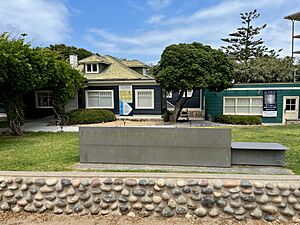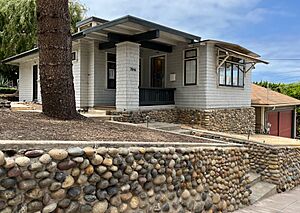La Jolla Historical Society facts for kids
The La Jolla Historical Society is a special group in La Jolla, California. It's a nonprofit organization that works to protect and share the history and culture of this beautiful coastal area. They help people learn about the past of La Jolla.
Contents
What the Society Does
The La Jolla Historical Society (LJHS) is like a unique history museum. They create interesting projects that connect different subjects. They work with artists, architects, and other creative people.
Programs and Events
The Society offers many fun activities. These include:
- Exhibitions that show off historical items.
- Presentations and discussions about local history.
- Tours of interesting buildings and gardens, like the Secret Garden Tour of La Jolla.
- Special programs for young people to learn about history.
- Community events, such as the La Jolla Concours d'Elegance.
The LJHS also helps the City of San Diego decide which old buildings in La Jolla should be protected as landmarks.
Historical Collections
The La Jolla Historical Society has many important collections. These include old photographs and documents. Some of their collections are listed online through the Online Archive of California.
Where to Find the Society
The La Jolla Historical Society is located on land that once belonged to a kind person named Ellen Browning Scripps. Her old house, South Molton Villa, is now the Museum of Contemporary Art San Diego.
How the Society Started
The La Jolla Historical Society (LJHS) began in 1964. A group of community leaders and local people wanted to save La Jolla's rich history and culture.
Early Efforts to Preserve History
The idea for the LJHS actually started much earlier, in 1936. That's when Howard S.F. Randolph, a historian from New England, came to La Jolla. He was very interested in how La Jolla first grew. Randolph worked with the Library Association of La Jolla, which is now the Athenaeum Music & Arts Library. He collected many old photographs and documents.
In 1946, Randolph published his book, La Jolla: Year by Year. This book made many people more interested in local history. Randolph's collection grew and became the main part of the huge collection of images and documents that the LJHS still keeps today. For many years, La Jolla's history efforts were connected to the Library Association.
A Time of Change in La Jolla
The 1960s brought big changes to La Jolla. There was a "land boom," which meant that land prices went up very quickly. Many small beach cottages were torn down. In their place, tall buildings and modern shops were built. Also, the University of California, San Diego and the Salk Institute for Biological Studies opened. This brought many new people with different ideas to the community.
Because of these changes, people realized that a separate group was needed. This new group would focus only on history and saving old buildings. So, on July 7, 1964, the La Jolla Historical Society officially started. Barbara Dawson was the first President. The Library Association then gave Randolph's large collection to the new LJHS.
Moving to a Permanent Home
The LJHS first had a small room in a bank building. Then, they met in private homes. In 1968, they got a small office. In 1971, they moved to the La Jolla Public Library. Six years later, they moved to the Colonial Inn. Finally, in 1981, the LJHS moved to its current location in the La Jolla Cultural District.
Today, the La Jolla Historical Society is a strong community group. It offers many programs and plans for an exciting future.
Historic Buildings at the Society
The La Jolla Historical Society is home to several important historic buildings.
Wisteria Cottage and Balmer Annex
Wisteria Cottage is at 780 Prospect Street. It's in the middle of the La Jolla Cultural District. This cottage is a great example of the unique old buildings from early San Diego. Today, Wisteria Cottage is a museum and a gallery for exhibitions. The Balmer Annex has a meeting room. This room is used for meetings, workshops, and educational programs.
History of Wisteria Cottage
Wisteria Cottage was built in 1904. Soon after, Virginia Scripps bought it. She was the half-sister of Ellen Browning Scripps. Between 1907 and 1909, a famous architect named Irving J. Gill added parts to the cottage. He built a wisteria-covered pergola near the entrance. Wisteria Cottage became part of a group of Scripps family buildings. By 1916, this group included South Molton Villa and other smaller buildings.
From the 1940s to the 1960s, Wisteria Cottage was home to the Balmer School. This elementary school later became La Jolla Country Day School. The Balmer Annex was added in the late 1940s. From the mid-1960s to 2005, the cottage was a bookshop. First, it was Nexxus Bookstore, then John Cole's Book Shop. In 1982, the cottage was added to the List of San Diego Historic Landmarks.
When Cole's Bookstore closed in 2005, Wisteria Cottage became the new home of the La Jolla Historical Society. In 2008, Ellen Clark Revelle and her family gave the entire property to the LJHS. She was the great-niece of Ellen Browning Scripps. Pat Dahlberg, who led the LJHS, helped a lot to get the property.
Wisteria Cottage was carefully fixed up to be a museum, education center, and community space. The work finished in 2014, just in time for the LJHS's 50th Anniversary. In 2014, the City of San Diego gave the LJHS an award for fixing up Wisteria Cottage. The LJHS also won the "Preservationists of the Year" award from Save Our Heritage Organisation.
The 1909 Cottage
The 1909 Cottage has been changed to be used as offices and a research area for the public. The rooms still have their original wooden walls, wavy glass windows, and pine floors.
Moving the Cottage
This cottage was first located at 245 Prospect Street. It was one of many seasonal houses built in La Jolla. These houses often had one or two bedrooms and no indoor plumbing or electricity.
The LJHS bought the cottage in 1981. They learned it was going to be torn down to build a new apartment building. The cottage was moved to its current spot at 7846 Eads Avenue. A developer named Dewhurst & Associates moved it. The Revelle Family helped pay for the move.
The 1917 Carriage House
The Carriage House has been updated to store the Society's historical collection. This collection includes old photographs, public records, private papers, and newspaper archives.
The Carriage House is on the land that used to belong to Ellen Browning Scripps. It was built in 1917 as a garage for Scripps' chauffeur's Ford car.
The 1996 Venturi Pergola
In 2018, the LJHS got and set up The Venturi Pergola. This pergola was designed for the Museum of Contemporary Art San Diego (MCASD). It has columns that look like old Roman style and an aluminum top. It was a modern design that responded to the work of early architect Irving J. Gill. The pergola is now a permanent part of the LJHS collection.




